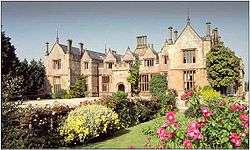Dillington House
| Dillington House | |
|---|---|
 | |
| Coordinates | 50°56′10″N 2°54′05″W / 50.93611°N 2.90139°WCoordinates: 50°56′10″N 2°54′05″W / 50.93611°N 2.90139°W |
| Built | 16th century |
| Governing body | Somerset County Council |
Listed Building – Grade II* | |
| Official name: Dillington House | |
| Designated | 4 February 1958[1] |
| Reference no. | 264045 |
Listed Building – Grade II* | |
| Official name: Nos.2 AND 3 and attached railings, gate piers and gates | |
| Designated | 23 September 1950[2] |
| Reference no. | 383364 |
Listed Building – Grade II | |
| Official name: Dillington Arts Centre | |
| Designated | 29 October 1987[3] |
| Reference no. | 264044 |
Listed Building – Grade II | |
| Official name: Fountain | |
| Designated | 29 October 1987[4] |
| Reference no. | 264047 |
Listed Building – Grade II | |
| Official name: Obelisk | |
| Designated | 29 October 1987[5] |
| Reference no. | 264048 |
 Location of Dillington House in Somerset | |
Dillington House is a residential adult education college located near Ilminster in the parish of Whitelackington, Somerset, England. The present house, which dates from the 16th century, is owned by Lord Cameron of Dillington and operated by Somerset County Council. There has been a house on the site since before the Norman Conquest,[6] probably taking advantage of the nearby chalybeate spring nearby.
College
Dillington House offers a range of day courses and residential short courses as well as a programme of public lectures . As well as being a centre for residential adult education, Dillington House is also a venue for conferences and meetings, weddings and other private events. The residential accommodation is set in historic parkland and gardens.
The house is the venue for regular classical music concerts held mostly on Sunday afternoons.[7]
History
The house has 16th-century origins, but was reshaped around 1838 by its then owner John.E.Lee to the design of Sir James Pennethorne. John Lee, who purchased the house, had been born John Hanning and had assumed the surname Lee on becoming the heir of his uncle Major Edward Lee (d.1819) of Orleigh Court, Buckland Brewer, North Devon. John Lee's brother-in-law and his tenant at Orleigh Court was William Speke of Jordans near Ilminster, father of the celebrated discoverer of the River Nile John Hanning Speke.[8] It is now a Grade II* listed building.[1] Dillington House was the country residence of George III's Prime Minister, Lord North who acquired it through marriage to Anne Speke.[9] The stables which were built in the 18th or early 19th century were remodelled in 1875 by George Nattress and later in the 1960s when the Coach House was converted into a theatre.[3] The two lodges adjacent to the main gate are also Grade II* listed and are in private ownership.[2]
In the spring of 2009 a new building was opened called 'The Hyde' which provides two studio spaces, additional dining accommodation and 15 fully accessible bedrooms. Designed by Tim Rolt and Dan Talkes of Purcell Miller Tritton, the building won the 2010 South-West Region Architecture Award from the Royal Institute of British Architects.[10]
References
- 1 2 "Dillington House". Images of England. English Heritage. Retrieved 7 March 2010.
- 1 2 "Nos.2 AND 3 and attached railings, gate piers and gates". Images of England. English Heritage. Retrieved 7 March 2010.
- 1 2 "Dillington Arts Centre". Images of England. English Heritage. Retrieved 7 March 2010.
- ↑ "Fountain, about 75 metres east of Dillington House". Images of England. English Heritage. Retrieved 7 March 2010.
- ↑ "Obelisk, about 70 metres south of Dillington House". Images of England. English Heritage. Retrieved 7 March 2010.
- ↑ Gathercole, Clare. "An archaeological assessment of Ilminster" (PDF). English Heritage Extensive Urban Survey. Somerset County Council. Retrieved 22 August 2011.
- ↑
- ↑ Rogers, W.H. "Buckland Brewer, 1938, p.53
- ↑ "Dillington House". Cafe du Monde. Retrieved 7 March 2010.
- ↑ "Awards". Purcell Miller Tritton. Retrieved 22 August 2011.
External links
| Wikimedia Commons has media related to Dillington House. |